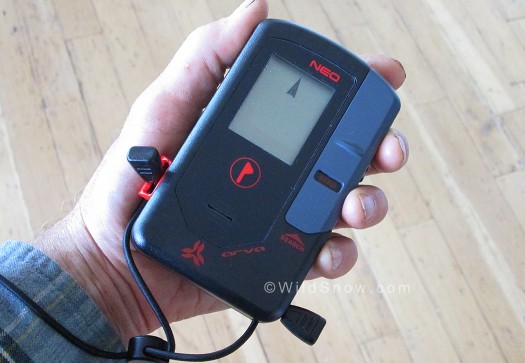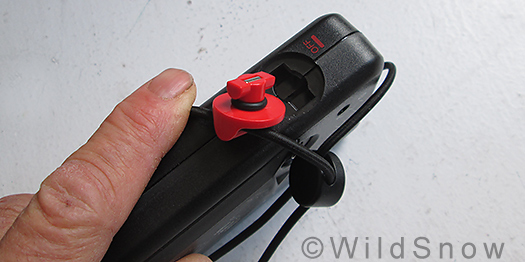The Arva Neo avalanche rescue beacon boasts a fairly compact form, excellent search range and reasonable price.
The claim is that not only Neo easy to use, but also a “performance” beacon that can yield “60 meters search bandwidth.” That’s a full 196.85 impressive feet. During range testing (with another name-brand beacon as signal source) next to our house, under power lines while weaving around a 3/4 ton pickup and a subcompact I still got 175 feet of useful range! That is exceptional — for comparison I tested a few other beacons we have laying around here and found some had half that range.
While you can search effectively with less range (unless you’re wandering the debris zone of a monster slide), doing so can slow down significantly due to the need to bracket or zig-zag to make sure you don’t miss a buried victim.
Reminder: another reason that beacon practice still rules is that in a possibly deadly accident, with minutes critical, you need to visually estimate your search field. You then determine what kind of zig-zagging or otherwise you’ll need to do. This is an example of how primitive avalanche beacons still are, as they depend on human spacial awareness that could be nearly non-existent in a tunnel vision affected responder during a companion rescue. Thus, more range is a good thing.
My beacon range torture test is done on my city sidewalk, that’s how I find out how well a unit does with RFI (radio frequency interference, the white noise emitted by just about anything electrical, including your brain.) I’m delighted to say my cabeza didn’t emit any false signals, but I did immediately see several ghost burials on the Neo LCD.
To be fair, despite the ghosts it was soon obvious what was what. Nonetheless, users who frequent sidecountry with power lines and such should always test their beacon in various locations to be sure confusion won’t be the rule during a search.
To get a better read on the RFI issue, I compared the sensitivity of Neo to another popular name-brand beacon and found that the Neo did slightly better, in that it didn’t pick up a false signal as easily. Considering the sensitivity of the Neo (again, I got about 170 feet search range in a worst-case situation), that’s some good electronics.
So, is this unit user friendly as claimed? Best test for that is to pull the thing out of the cardboard and use it without study and without much practice. My take in just such a scene:
Noise: Audio feedback in addition to visual is a welcome part of any beacon. But without a volume control the sometimes ear-drilling screeches of the Neo may be too much, especially during practice. More, if the unit rocks an error code you-will-pay-attention. Interestingly, I could easily trigger the error howl when I set another beacon on top of the Neo, but sandwiching it under my operating Galaxy Note smartphone had no effect (though I’m certain doing this would somewhat attenuate the transmitting signal.)
Multiple victims:
While multiple burial features still fascinate many backcountry journalists and PR scions, they’re my least favorite subject (ski one at a time!). But reality intrudes on my fantasy of perfection.
Quite a few multiple-victim accidents happen every season — and my own behavior is never perfect so yes, it could happen to me. I’d call the Neo mark/mask function “intuitive.” But you still need to practice once you’re in the terrifying realm of having several buried victims at the same time.
(Note, much of the multiple burial hype is pure fantasy, as the chances of digging people alive out of avalanches are quite low anyway and once you’ve got several to deal with the odds drop like a 300 pound cliff hucker. As in, who will you dig up first? More, with a modicum of practice you can find multiple burials with just about any beacon, mark/mask function or not.)
Controls:
Neo is switched on by inserting a red plug attached to an elastic lanyard. These sorts of “detached” switches always seem fiddly to me. I guess the idea is to force you to use the lanyard or else risk losing the switch. Whatever — you’ll learn to live with it.
Changing from send to search mode is obvious, just push the big grey slider switch (visible in images on right side of unit, color bluish grey due to photo processing). Only glitch with this is that getting enough friction to push the switch could be difficult with wet or slippery gloves. It won’t get switched accidentally.
Mark/mask is indicated by a button with a flag icon. After a bit of practice it’s pretty obvious how this works: Multiple received beacon signals are indicated by human figures in the LCD, get close to a victim and hit the mask button which takes them out of the search. Trick is knowing how to behave when you’ve got multiple victims. One or two practice sessions will take care of that.
Harness: The small elastic lanyard retaining the switch plug is a nice way to safe the beacon to your wrist. Unit carries okay in pocket, or use the included pouch/harness which has a dense foam back you can face the LCD towards for added protection. Harness is pleasantly basic with one strap around the waist and one over the shoulder. In a thoughtful touch, the straps are colored differently (one red, one black) so you’ll have less tangle.
Battery life, weight, etcetera:
Neo is rated for 10 full 24 hour days transmit, meaning you’ll probably need new batteries after about every 10 days of use assuming you’re out for a normal trip. That way you keep the batteries at 50% or better so you have plenty of power for a search. Weight and size are average: 24 mm thick (plus battery case that protrudes a few more mmm) x 120 mm tall x 75 mm wide, 252 grams with removable switch and small lanyard, batteries installed.
Conclusion:
Highly sensitive beacon with excellent search range. Recommended for use in developed areas such as resorts due to good handling of errant signals as well as mark/masking function that’s intuitive and helps cut ghost signals. Would I hand this beacon to am inexperienced partner, give a five minute lesson, and go skiing? Yes. (But as with any beacon, some extended practice sessions would of course be better.)
Arva Neo will be available this fall. Will probably retail for around $350 — that’s average to good if you do a quick web price survey. Christmas gift?
WildSnow.com publisher emeritus and founder Lou (Louis Dawson) has a 50+ years career in climbing, backcountry skiing and ski mountaineering. He was the first person in history to ski down all 54 Colorado 14,000-foot peaks, has authored numerous books about about backcountry skiing, and has skied from the summit of Denali in Alaska, North America’s highest mountain.



